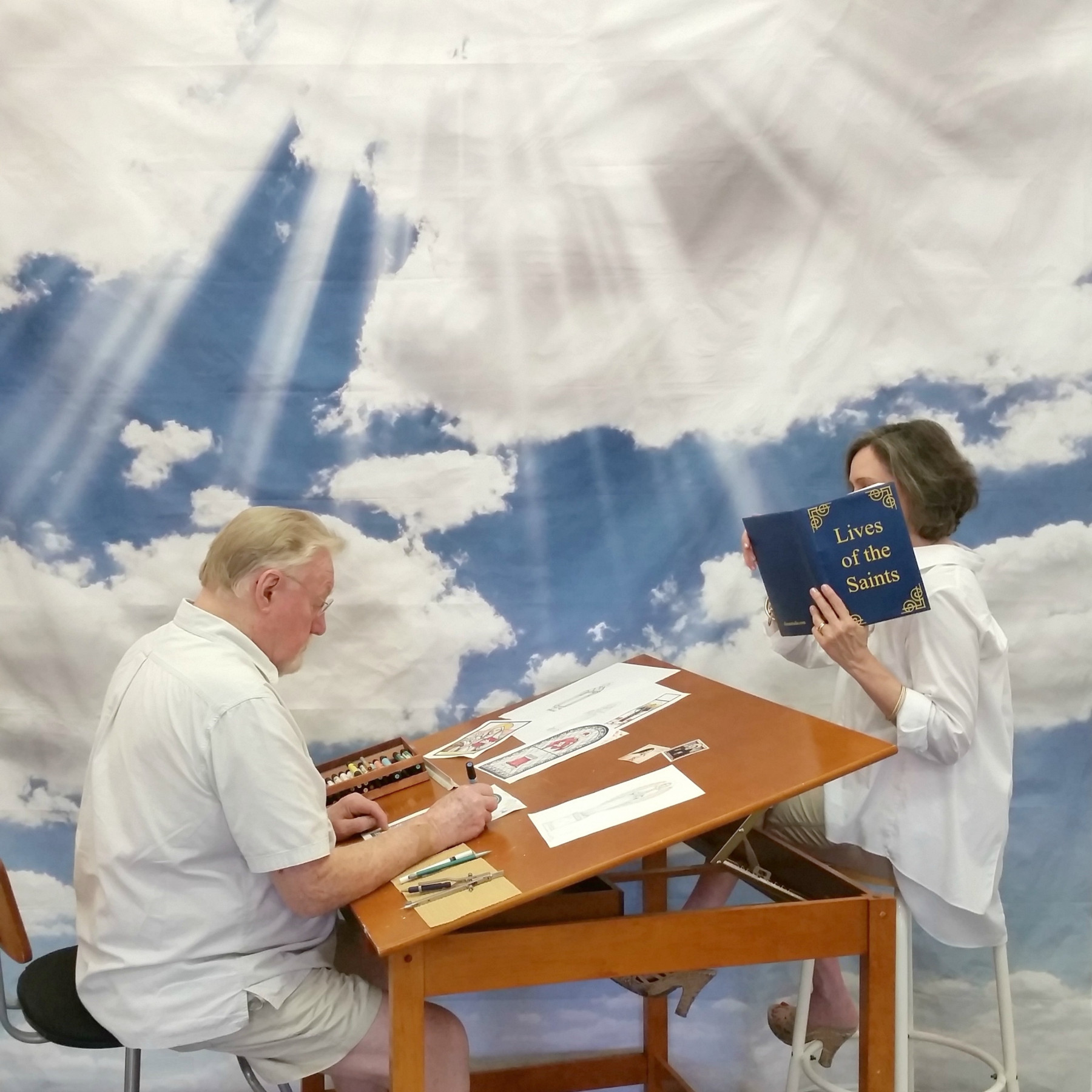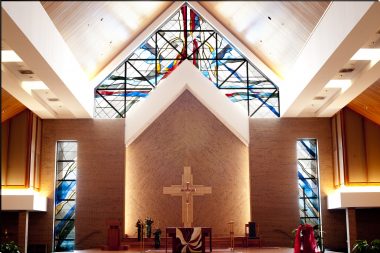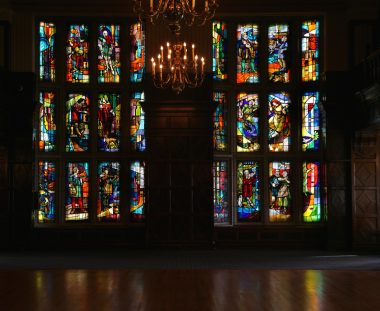Stained Glass Artist Delights in Lighting Up Rooms With Color Across US

Ronald Dixon, left, and his wife, Annie, started Dixon Studio, which specializes in stained glass and other art for churches. (Courtesy of Annie Dixon)
As a young boy in Ireland, Ronald Dixon was drawn to how sunlight made stained glass art come alive.
The son of an organist and choirmaster, Dixon spent much of his childhood in church, for years admiring the craftsmanship of those who created the work that captured his imagination. Dixon came to the U.S. in his 20s, and enjoyed a long career as a stained glass artist and graphic designer.
“In general, it just sort of drew me towards it plus I was quite mechanical. And it’s an interesting craft,” Dixon said in an interview with aHUS News. “It’s from a small brush to hard hat and scaffolding and all that.”
Events, weddings, and church services have been held under Dixon’s stained glass artistry. One of his earliest works from 1964 is now being used by the Hyatt for its Hotel Kansas City. The work consists of 24 panes of stained glass windows outlining what life was like in the Tudor period in England and Wales between the 13th and 15th centuries. It used to illuminate a private club, but has now been transformed into an event space.
However, credit for the work was incorrect for a long time. When writing a 2014 book on windows in Kansas City, author Bruce Mathews discovered the Tudor project was in fact Dixon’s masterpiece and his signature was eventually found on a handful of panes. The hotel promptly changed the name on the plaque that introduces the piece.
Lighting the way with art
Dixon met Annie Rodriguez in 1989 after moving to Virginia from Kansas City where he worked for Hallmark. The two married the following year and together started Dixon Studio, specializing in stained glass and other art for churches. The business is based in Staunton, Virginia, in a 6,000-square-foot studio, showroom, and workshop, where Ronald has completed a number of pieces for churches in Alabama, South Carolina, Florida, Washington, and North Carolina.
Most of his stained glass pieces depict stories from the Bible, saints, Jesus, doves, and other Christian symbols that span all denominations. Both Ronald and Annie are Christians; he’s a Protestant and she’s Catholic.
The process of creating a stained glass piece combines a number of artistic disciplines. First, Ronald starts with a full drawing of the window. Then, he picks colors, cuts the glass, and installs it in the window frame.
Annie, who has a degree in English, has experience running a printing press, and stints as a graphic designer. She said her role has been to manage the business, help it run more smoothly, expand its offerings, and let her husband focus on the artwork.

Ronald Dixon’s stained glass work at Christ the Redeemer Catholic Church in Sterling, Virginia. (Courtesy of Annie Dixon)
“It just seemed like a good match that my job could be packaging that,” said Annie, a former columnist for aHUS News. “This is the talent and I push that out into the world.”
Six years ago, Annie took on a new role — that of caregiver — after Ronald was diagnosed with atypical hemolytic uremic syndrome (aHUS) following a bout of food poisoning. Genetic tests revealed he had no predisposing features for the disease.
Annie recalled how everyone was confused the night Ronald was admitted to the hospital, but one doctor suspected aHUS, a rare disease that causes blood clots to form in small blood vessels.
“I was shuffled around with gurneys and tapes and tubes and machines and all sorts of medical treatments,” Ronald said.
“I was just so surprised that something like that happened,” Annie said, remembering her thoughts during the crisis that nearly took her husband’s life.
Managing a business and a diagnosis
Annie’s new support role included learning about peripherally inserted central catheter lines, counting medications, taking notes during doctor’s visits, and taking Ronald’s blood pressure. The diagnosis upended the couple’s life and their business.
Annie pivoted to more consulting work and selling metalware and statues to churches, giving Ronald the extra time he needed to complete major stained glass projects.
“It became more important to do things like [metalware and statues], so that it was less taxing on him,” Annie said.
The husband-wife team has also had to learn to be more flexible with their working hours and about embarking on trips to meet with church leaders. Mornings are especially hard on Ronald because he has low energy then.
Once he received a diagnosis and was started on Soliris (eculizumab), he immediately started feeling better. He was on the medication for a year before he stabilized enough for doctors to wean him off it, but he continues to monitor his red blood cell count and platelets.
Fatigue remains his biggest challenge, but stopping his work is out of the question, Ronald said. Stained glass has been part of his life for a long time.

The stained glass Tudor Room at Hotel Kansas City. (Photo by Bruce Mathews)
“As long as … he has enough energy to do what he wants at this age, that’s fine,” Annie said. “Symptoms are sort of underlying, they’re not painful. They’re not emergency-level things.”
Ronald said he is happy that he’s able to keep his aHUS stable and can continue bringing colorful light into rooms across the country.
He’s currently working on 12 stained glass pieces for St. Mark Catholic Church in Huntersville, North Carolina, after having just completed 22 pieces of the life of Christ for the same church, which took two years to finish.
“The more I did my work and more confident I got back in it, that’s kind of when I realized, OK, I’m here for a reason,” Ronald said.







